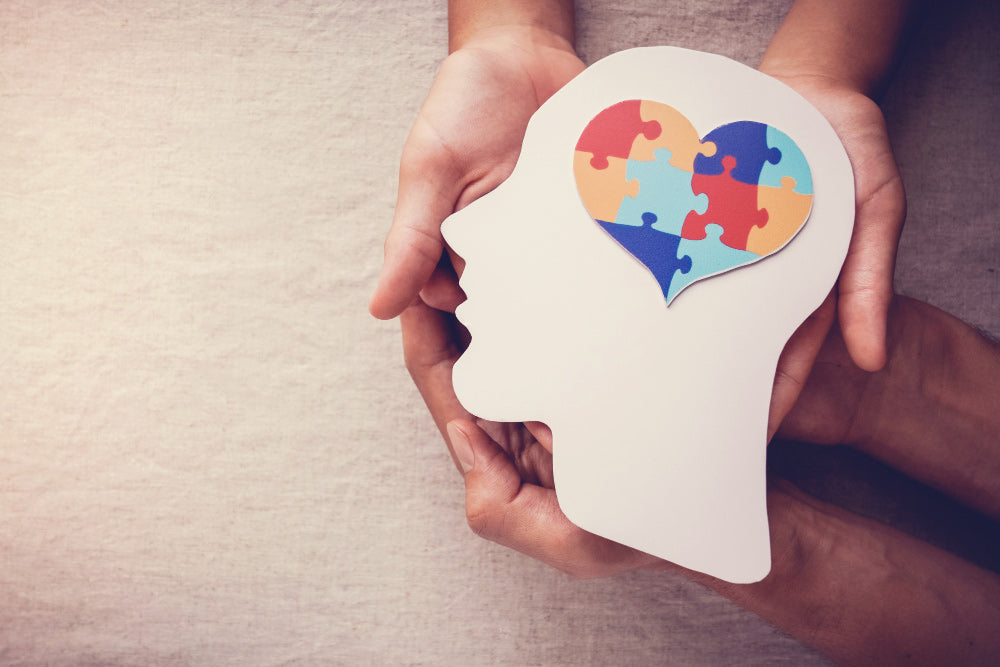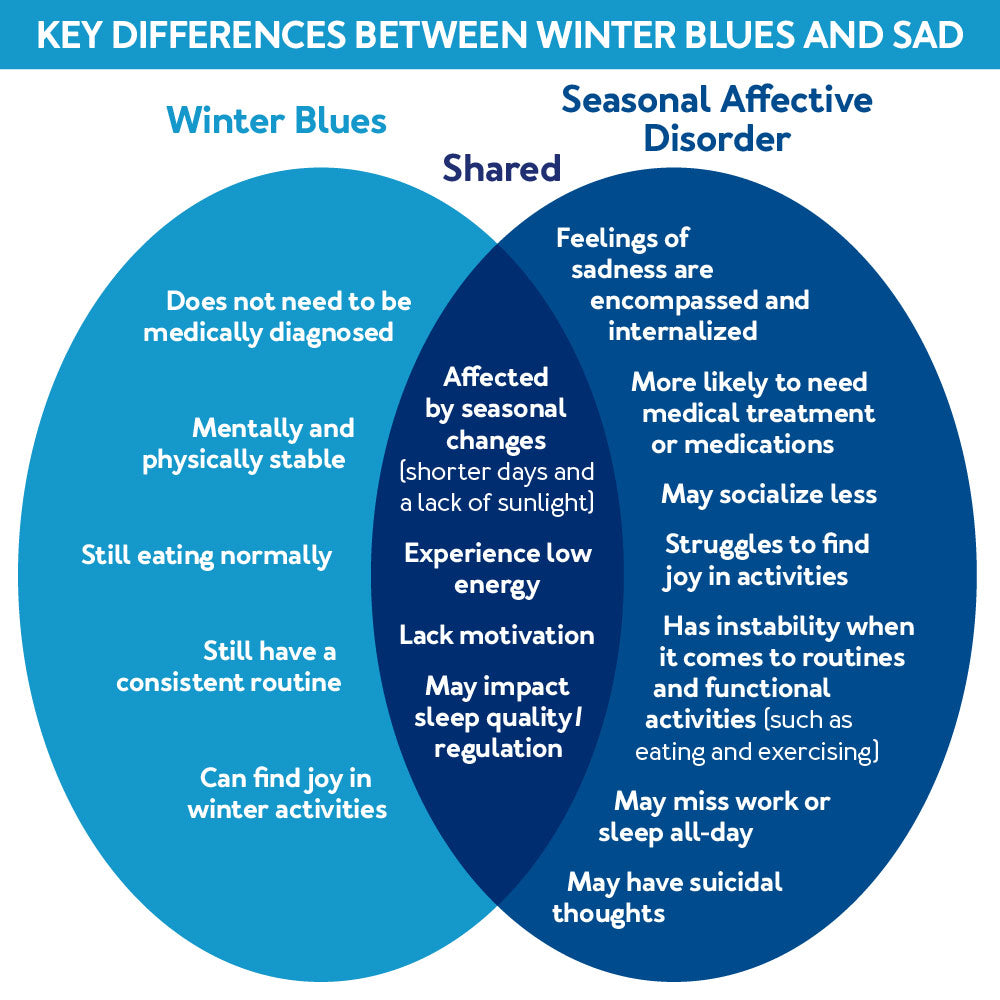
Winter Blues vs. Seasonal Affective Disorder
The phrase "Winter Blues" and "Seasonal Affective Disorder" are often mentioned interchangeably during the winter season. There is a tendency to use these phrases synonymously, but they are not. One is a condition where the season and lack of light create a depression that affects all parts of their mental health, and the other is a temporary feeling.
What are the Winter Blues?
When someone has the "winter blues," they feel a temporary form of sadness, where the person may feel down in the dumps because of the shorter darker days, or the inability to go outside because of all the ice outside. It's gloomy, ugly, and altogether, it is not the best condition for doing all the activities you may want to do. Overall, the winter blues are temporary, unfortunate, and do not need to be medically diagnosed.
Many people can have the winter blues because of the cold dark season, but it doesn't affect them internally. That means, even though you have the winter blues, your mental health and physical health is still stable. You are still eating normally, you still have a consistent routine that you can stick with, regardless of the weather, and you can still find some joy in winter activities.
What is Seasonal Affective Disorder?
On the other hand, Seasonal Affective Disorder (SAD) may look similar on the outside but is not the same on the inside. Yes, someone with SAD may look like they also feel down because of the shorter days and the inability to do the things they enjoy, but the difference comes with how someone internalizes the feeling.
With Seasonal Affective Disorder, the "feeling" of sadness and depression encompasses their entire being. As the fall and winter seasons go on, those with SAD cannot do basic tasks in their everyday life that they may be responsible for. They may socialize less, become more sluggish and stay in bed, or neglect to maintain healthy eating habits. They may miss work or sleep all day. Seasonal Affective Disorder affects the daily life that needs to be maintained. SAD is something that can be medically diagnosed.
Symptoms Seasonal Affective Disorder
Symptoms of Seasonal Affective Disorder include:
- Loss of social interest
- Weight gain
- Sluggishness
- Low energy
- Feeling hopeless and worthless
- Lack of motivation
- Suicidal thoughts
Seasonal Affective disorder is typically similar to someone who has any other type of depression. The main reason for Seasonal Affective Disorder is the lack of sunlight, which disrupts the body's internal clock and leads to depression. That means mental, physical, and spiritual health is compromised in their daily life and they are at risk of dangerous thoughts and acts. People who suffer from SAD can negatively affect themselves or their surroundings due to their depression, and it is imperative to support those who suffer from it.
What are the Similarities Between These Two?
Seasonal Affective Disorder and the Winter Blues become interchangeable because they are both negative emotional experiences affected by the shorter days and the general season. It is very common to mistake one for the other and may even be difficult to differentiate when deciding whether to talk to a doctor or not.

Why is it Important to Identify the Difference?
While they are both associated with the winter weather, one is a feeling where you are "bummed out," and another encompasses the basics and maintenance of your mind and body. One does not affect your overall outlook of life and self, and one makes adverse decisions to the mind and body by not taking care of it with helpful treatments. You need to identify the difference between the Winter Blues vs. Seasonal Affective Disorder because treatment can begin when the issue is identified.
If you feel that your friend may seem down during the winter seasons, ask yourself, does it seem like an ongoing pattern? Do they go out less? Do they not eat properly or take care of themselves anymore? Are they always sleeping? Make sure you listen to their thoughts. What kind of thoughts do they have? If they have suicidal thoughts or thoughts involving lack of self-worth and hopelessness, they may have Seasonal Affective Disorder. They may have the winter blues if they are just "bummed out" about the weather. Maybe you believe that you have Seasonal Affective Disorder, and you identified these symptoms in yourself. There are plenty of ways to treat SAD.
Some treatments for Seasonal Affective Disorder include:
- Light therapy
- Dawn alarm clock
- Sitting by the fire
- Spending time with friends and family
- Completing realistic tasks
- Maintaining a routine
- Finding support
- Monitoring your eating habits
- Talk to your doctor
Like any other mental health issue, Seasonal Affective Disorder needs to be addressed and treated like any other sickness. It is not a temporary emotion, and brushing someone off and claiming that they have the "winter blues" can invalidate their feelings, deepen the depression, and prolong what could be treated and supported.
If you are struggling with Seasonal Affective Disorder, try the treatments above and find a friend that will help keep you accountable. It is easier to have supportive and understanding people surrounding you to help you get back on your feet when battling SAD.
If you feel a friend may struggle with SAD, talk to them and support them. That may look like cooking them a nutritious meal or taking them out for fresh air. Maybe even helping them clean around the house. The environment makes a huge difference.
Conclusion
Whether it is Seasonal Affective Disorder or the Winter Blues, make sure you take care of yourself as the fall and winter seasons come and go. Take an extra effort to be aware of the oncoming season and maintain your mental health and healthy habits. Your mental health should be prioritized just like your physical health.
Helpful Seasonal Affective Disorder Resources
About the Author

Brandon Landgraf is the Digital Marketing Manager for Carex Health Brands. He finds passion and fulfillment in creating content that enhances, improves, and enlivens others' quality of life. All of his written work is formulated to not only offer essential advice and tips but back it with proven studies and experts. His mission is to connect with readers and provide steps to make their lives better.
You can connect with him on LinkedIn here.
About Carex Health Brands
Carex is your one-stop shop for home medical equipment and for products that assist caregivers with providing the best possible support and care for their loved ones. Carex Health Brands has been the branded leader in in-home, self-care medical products for over 35 years. Our goal is to improve the lives of our customers by bring them quality products that bring dignity back to their lives. With our three nationally distributed brands, Carex Health Brands serves national, regional and independent food, drug and mass retailers along with wholesalers, distributors and medical dealers.





